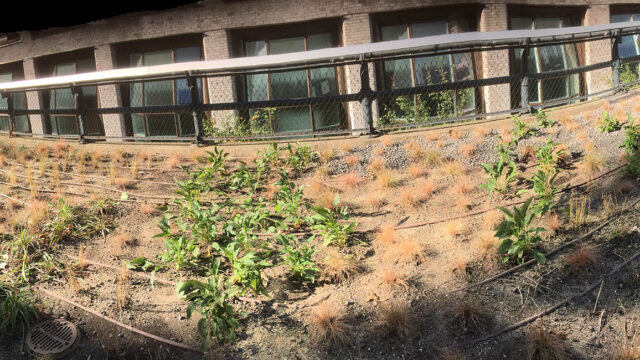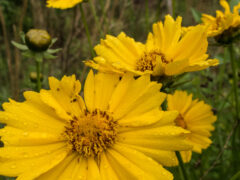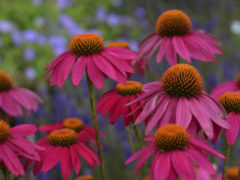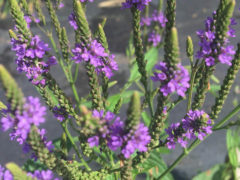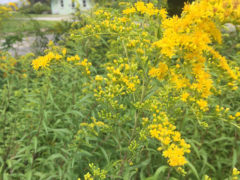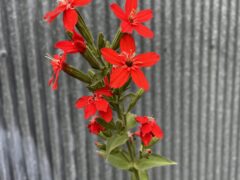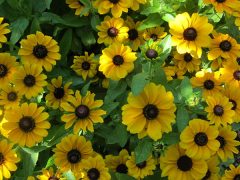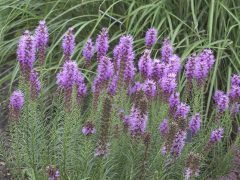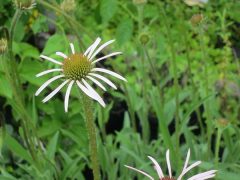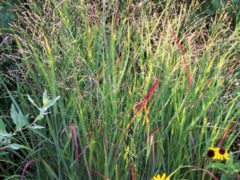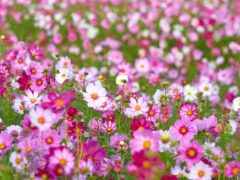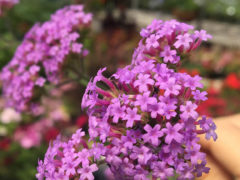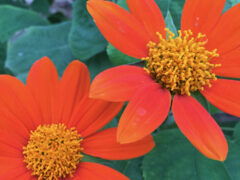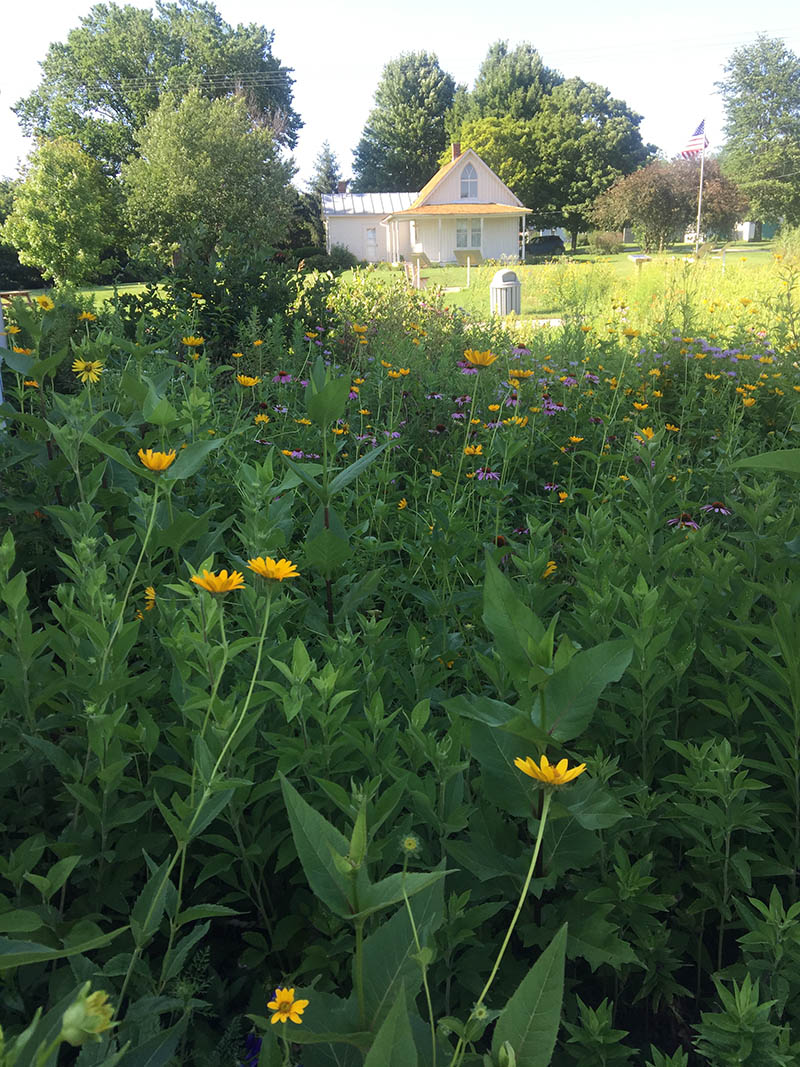
Create a swath of mixed flowering annuals or perennials of most any size!
Set your footprint. Whether you want to fill a difficult to mow area, or create a small corner for pollinators, measure and jot down the dimensions of your space.
When do you want it to bloom? Is summer your target for color (consider native prairie plants), or do you want to go from spring to first frost (you’ll have to use annuals and replant each year)?
Decide on a maximum height. On an roadside easement, you will likely want to keep things to a maximum 24″ height for driver visibility, but if you’re creating a screen for an electrical box or structure you might want something taller. If it gets over 3 feet high it will be difficult to see the variety of your bloom color unless viewing from a deck or other higher vantage point.
Choose a palette of 3 or more plants of similar height and bloom time,
light and moisture needs, and growth vigor (vigorous growers can crowd out slower plants).
Use this handy calculator to figure out how many plants you will need for your space. For example, a 3′ x 10′ swath is 30 square feet, and planted with 12″ spacing means you will need 18 plants. If you select 3 types of plants you will need 6 of each, planted in a random, alternating mix.
(IMAGE, TOP) By Amy Albright in November 2021 on The High Line, a 1.45-mile-long elevated linear park, greenway and rail trail created on a former New York Central Railroad spur on the west side of Manhattan in New York City. This section was newly planted. The gardens were gorgeous even in late fall.
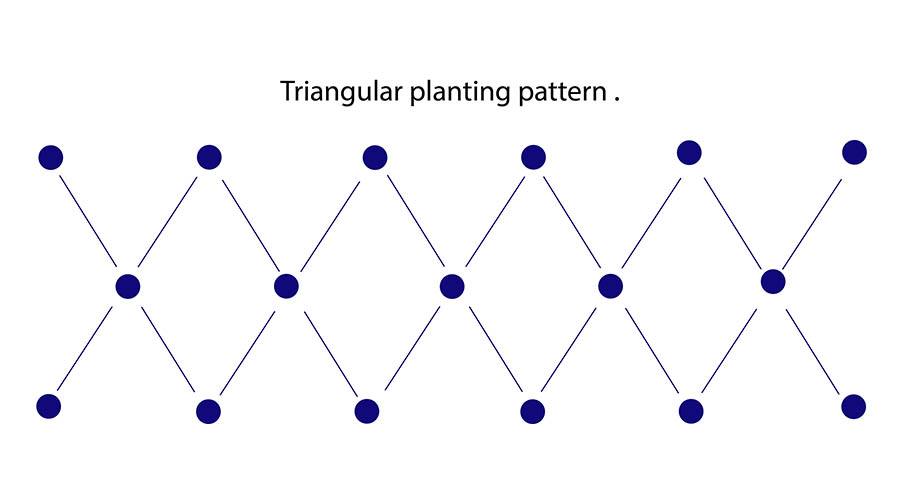
Here are three possible plant combinations to consider:
1) A low, drought and heat tolerant native prairie meadow for a 3′ x 10′ area that blooms from late May through early August using three kinds of plants spaced 12″ apart. Total of 18 plants.
Use six Coreopsis lanceolata.
lanceleaf tickseed
Coreopsis lanceolata
Lanceleaf tickseed sports bright yellow, daisy-like flowers in summer over glossy green foliage. Plants self-seed and spread freely. A prairie native great for naturalizing with grasses and other self-seeders. Grows 1-2' tall in full sun.
You will need six.
‘PowWow Wild Berry’ coneflower
Echinacea purpurea 'PowWow Wild Berry'
Echinacea purpurea 'PowWow Wild Berry' is an AAS Winner that differs from other coneflowers in flower color, branching and plant size. The incredibly vivid deep rose-purple flowers retain color longer. This first year flowering perennial has superior performance including a basal branching habit that results in more flowers per plant. Expect rapid and uniform flowering at a day-length of 14 hours. Reaching a mid-height of 20-24 inches in the full sun garden, it will bloom continually without deadheading or grooming. SELECTION OF NATIVE.
TRY THE NATIVE!
[plant id="3097"]
You will need six.
American vervain
Verbena hastata
Easily grown in average, medium to wet soils in full sun. Forms colonies in the wild by slowly spreading rhizomes and self-seeding. A lovely little garden filler makes great cut flowers and attracts pollinators by the score. Seeds are eaten by cardinals, swamp sparrows, field sparrows, song sparrows, and dark eyed juncos.
All of these natives will compete for growing space at about the same rate and self-seed moderately to fill in a sunny space. Once established they won’t ask for much of anything, and flower tops can be left through winter for extra seasonal interest and to provide bird food and wildlife cover.
2) A 3-4′ tall, wild prairie look for a 6′ x 18′ sunny area that blooms May through September using six types of plants spaced 18″ apart. Total of 32 plants.
Use five Solidago ‘Fireworks’.
Showy Goldenrod
Solidago speciosa
Showy goldenrod is a rhizomatous native perennial which typically occurs in dry soils in open woods, fields and prairies. Tiny, bright yellow blooms open in dense clusters atop stiff, reddish stems growing 2-3' tall. Flowers bloom mid to late summer. As the common name suggests, this species is one of the showiest of the many goldenrods. Goldenrods have been wrongly blamed for causing hay fever which is actually an allergic reaction to wind-borne pollen from other plants such as ragweed. Attractive to bees and butterflies searching for late-season nectar, and especially valuable to migrating Monarchs.
Used by long-tongued bees, short-tongued bees, wasps, flies, beetles, butterflies, and caterpillars of many Lepidoptera species. An important late-season nectar source for pollinators.
Use six.
royal catchfly
Silene regia
Hummingbirds and swallowtail butterflies are attracted to this bright red flowering native. Sticky glands cover the plant and insects often become fatally trapped. Although related to carnivorous plants and containing digestive enzymes, royal catchfly does not absorb nutrients from its victims. It's thought to be defensive, protecting the plant from harmful foliage-eating insects. After becoming stuck, the insects die and the enzymes quickly break down the insect bodies.
Use five Rudbeckia hirta.
‘Goldsturm’ black-eyed Susan
Rudbeckia fulgida var. speciosa ‘Goldsturm’
Perennial Plant Association 1999 Perennial Plant of the Year!
Bushy clumps of rich green foliage are covered with 2-2.5”, golden-yellow blooms held just above the foliage. Very well-branched scapes carry loads of flowers from midsummer through early fall.
SELECTION OF NATIVE.
Use six Liatris pycnostachya or L. spicata.
Kansas gayfeather
Liatris spicata 'Kobold'
An early summer blooming lavender spikes grow to 3' tall. Great flower arrangement subjects that also attract butterflies. Plant in full sun to part shade. 'Kobold' is a small, compact, upright, cultivar which typically grows 2-2.5' tall. NATIVE TO THE EASTERN HALF OF THE U.S.
Use five.
pale purple coneflower
Echinacea pallida
Echinacea pallida is easily grown in average, dry to medium, well-drained soil in full sun to part shade. Best in full sun. An adaptable plant that is tolerant of drought, heat, humidity and poor soils. Divide clumps when they become overcrowded, about every 4 years. Plants usually rebloom without deadheading. Freely self-seeds if at least some of the seed heads are left in place.
Use five.
‘Shenandoah’ red switchgrass
Panicum virgatum ‘Shenandoah’
Best burgundy-red coloring of all the switch grasses. Deep-green foliage takes on red hues by midsummer. The coloring becomes more pronounced until it turns deep burgundy-wine by September. Tolerates a wide range of soil. NATIVE TO NORTH AMERICA MINUS WESTERN COASTAL STATES. [gallery link="file" columns="1" size="medium" ids="6089"]
3) A cacophony of annuals to bloom all summer for a 2′ x 10′ space in full sun using three kinds of plants spaced 12″ apart to grow 24-30″ high. All attract pollinators and grow happily in hot, dry conditions. Total of 10 plants.
Use three.
cosmos
Cosmos bipinnatus
Cosmos bipinnatus ia an heirloom garden classic, cosmos 'Sonata' flowers open in shades of violet, white over fine, ferny foliage. Cosmos is a wonderful self-seeder, and will wind its way through your garden from year to year. Just pull the plants that come up where you don't want them! Sea Shells features interesting rolled and ruffled petals in mixed shades of red, pink and white. Can grow as tall as 6'! 'Sensation' mix has lavender, magenta, pink and white single flowers with orange-yellow centers on plants reaching 4.5' tall.
Use four.
tall verbena/Brazilian vervain
Verbena bonariensis
Tender perennial is winter hardy to USDA Zones 7-10. In colder zones, grow as an annual in average, moist, well-drained soils in full sun to part shade. Plants freely self-seed and naturalize in gardens throughout perennial plantings. A wonderful pollinator nectar food and cut flower for arrangements!
Use three.
torch tithonia, Mexican sunflower
Tithonia rotundifolia
Native to Mexico and Central America, this vigorous annual typically grows 3-4’ tall. Showy flowers up to 3” across with orange to orange-red rays and orange-yellow disks bloom from mid-summer to fall provide nectar for pollinators. Great cut flower.
We’re here to help you figure out just the right plant combination for your site. Just bring in the dimensions of your space, light conditions, and an idea of your priority for the planting — screening, pollinator support, low-maintenance — and we will help you select exactly what you need!
